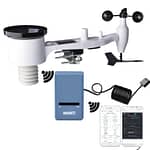Sometimes, providing power is a pain, I have an Ecowitt camera that only accepts power by USB type A, I needed a longer length of cable or an alternative solution. Well before the alternative solution, I needed to know where the power was coming from, so this article was conceived to save others time.
On to the solution, where I live has extremes of weather, so a standard USB extension will not work, so my cunning plan was to run external UTP (network cable) to as close to the device as possible and apply PoE (Power over Ethernet) and then wire the Ethernet into the USB cable. Having PoE will allow for other devices upon the external mast also, which in turn having one wire instead of four or five is a great advantage. More on this build will become available as I construct the solution.
Universal Serial Bus (USB) has evolved from a simple data interface into the dominant method for powering and charging electronic devices. Understanding how USB delivers power, the different plug types, and their pin-outs is essential for anyone working with modern electronics, from hobbyists to engineers.
USB Power Delivery: How Much Power Can USB Provide?
USB began with modest power capabilities, but today’s standards support a wide range of devices, from small wearables to power-hungry laptops.
- USB 2.0: Up to 5V at 500 mA (2.5W)
- USB 3.0/3.1: Up to 5V at 900 mA (4.5W)
- USB Battery Charging (BC) 1.2: Up to 5V at 1.5A (7.5W)
- USB-C (non-PD): Up to 5V at 3A (15W)
- USB Power Delivery (PD): Up to 48V at 5A (240W), with flexible voltage and current profiles for a wide range of devices.
With USB Power Delivery (PD), devices can negotiate for intermediate voltages (e.g., 9V, 15V, 20V, 28V, 36V, 48V) and higher currents, enabling fast charging and powering larger devices like laptops and monitors.
Types of USB Plugs
| Type | Shape/Description | Common Use Cases | Data/Power Support |
|---|---|---|---|
| USB Type-A | Flat, rectangular | PCs, chargers, hubs | USB 1.1–3.x, 5V power |
| USB Type-B | Square, beveled corners | Printers, scanners, external drives | USB 1.1–3.x, 5V power |
| Mini USB | Small rectangle | Older cameras, MP3 players | USB 2.0, 5V power |
| Micro USB | Thin, trapezoidal | Phones, tablets, accessories | USB 2.0/3.0, 5V power |
| USB Type-C | Small, oval, reversible | Modern phones, laptops, peripherals | USB 3.1–4.0, up to 240W PD |
| Lightning | Compact, reversible (Apple only) | iPhones, iPads | Proprietary, up to 20W |
USB Type-C is now the universal standard for new devices, supporting high-speed data, video, and high-wattage charging.
USB Pin-outs: What Each Pin Does
USB Type-A Pin-out (USB 2.0/3.0)
| Pin | Name | Function |
|---|---|---|
| 1 | VBUS | +5V Power |
| 2 | D- | Data – |
| 3 | D+ | Data + |
| 4 | GND | Ground |
| 5-9 | (USB 3) | SuperSpeed pairs |
- USB 3.0 adds five more pins for Super Speed data transfer3.
USB Type-B, Mini, and Micro Pinouts
- Type-B, Mini, Micro connectors have similar pin-outs, with VBUS, D-, D+, GND, and sometimes an ID pin for distinguishing host/device roles.
USB Type-C Pin-out (Simplified)
| Pin Group | Function |
|---|---|
| VBUS | Power (up to 20V, 5A with PD) |
| GND | Ground |
| D+, D- | USB 2.0 Data |
| CC | Configuration Channel (orientation, PD) |
| SBU1/2 | Sideband use (e.g., Alternate Modes) |
| SSTX/SSRX | Super Speed differential pairs (USB 3.x/4) |
- Type-C has 24 pins, supporting reversible insertion and advanced features like alternate modes (HDMI, DisplayPort) and high-wattage power delivery.
Choosing the Right USB Plug and Pin-out for Power
- For simple 5V power (charging small devices): Any USB-A, USB-B, Micro, or Mini USB cable will work. Match the plug to your device.
- For fast charging or high-power devices (laptops, monitors): Use USB-C with Power Delivery, ensuring both cable and charger are rated for the required wattage.
- For custom wiring or repairs: Reference pinout diagrams to ensure correct connections, especially for VBUS (power) and GND. Incorrect wiring can damage devices.
Conclusion
USB’s versatility comes from its evolving standards and connector types. Whether you’re charging a phone, powering a Raspberry Pi, or running a laptop dock, understanding plug types and pin-outs ensures safe and efficient power delivery. Always use quality cables and consult pin-out diagrams when making custom connections.
Hi I am Marcus, MM0ZIF, a licenced Radio Amateur, Doctor of Musicology, amateur weather enthusiast. I over the years have been a Amateur Radio Tutor, Examiner, and a Regional Manager for the Radio Society of Great Britain.
This site is dedicated more towards Amateur Radio and Weather, with an angle on Technology too. I also maintain https://havenswell.com/ which is my other blog which is more aimed at cooking, hobbies and life in general as well as businness and networking.










